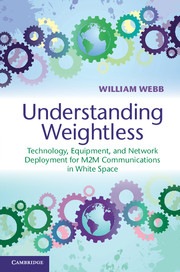 Understanding Weightless
Understanding Weightless Published online by Cambridge University Press: 05 April 2012
Security in general
Security is important in many machine applications. Smart grids must return accurate meter readings that cannot be modified. Network communications to instruct meters to change demand must not be modified or sent by a terrorist organisation. Financial-related transactions must be secure and it must be certain that they were received. Almost all machine communications have some level of security requirements.
To some degree these could be layered over the top of the Weightless network at the application layer. So a smart meter could encrypt its data stream before passing it to the Weightless radio embedded within it. The data would pass through the Weightless network in secure form and be decoded by the client in their central IT system. Indeed, this can be done even when Weightless has its own security to provide extra protection.
There are some functions that cannot be achieved at the application layer. These include authentication of the network by the Weightless device. Itwould be possible for a terminal to be ‘captured’ by a rogue base station and stay attached to it indefinitely. Authentication mechanisms are needed to prevent this occurring. Because of this, and because it prevented all applications having to build in their own security, it was decided to provide the Weightless standard with cellular-grade security mechanisms. However, as will be explained, some of the differences in message type and threat type mean that the same security mechanisms as are used in cellular cannot just be copied.
To save this book to your Kindle, first ensure [email protected] is added to your Approved Personal Document E-mail List under your Personal Document Settings on the Manage Your Content and Devices page of your Amazon account. Then enter the ‘name’ part of your Kindle email address below. Find out more about saving to your Kindle.
Note you can select to save to either the @free.kindle.com or @kindle.com variations. ‘@free.kindle.com’ emails are free but can only be saved to your device when it is connected to wi-fi. ‘@kindle.com’ emails can be delivered even when you are not connected to wi-fi, but note that service fees apply.
Find out more about the Kindle Personal Document Service.
To save content items to your account, please confirm that you agree to abide by our usage policies. If this is the first time you use this feature, you will be asked to authorise Cambridge Core to connect with your account. Find out more about saving content to Dropbox.
To save content items to your account, please confirm that you agree to abide by our usage policies. If this is the first time you use this feature, you will be asked to authorise Cambridge Core to connect with your account. Find out more about saving content to Google Drive.